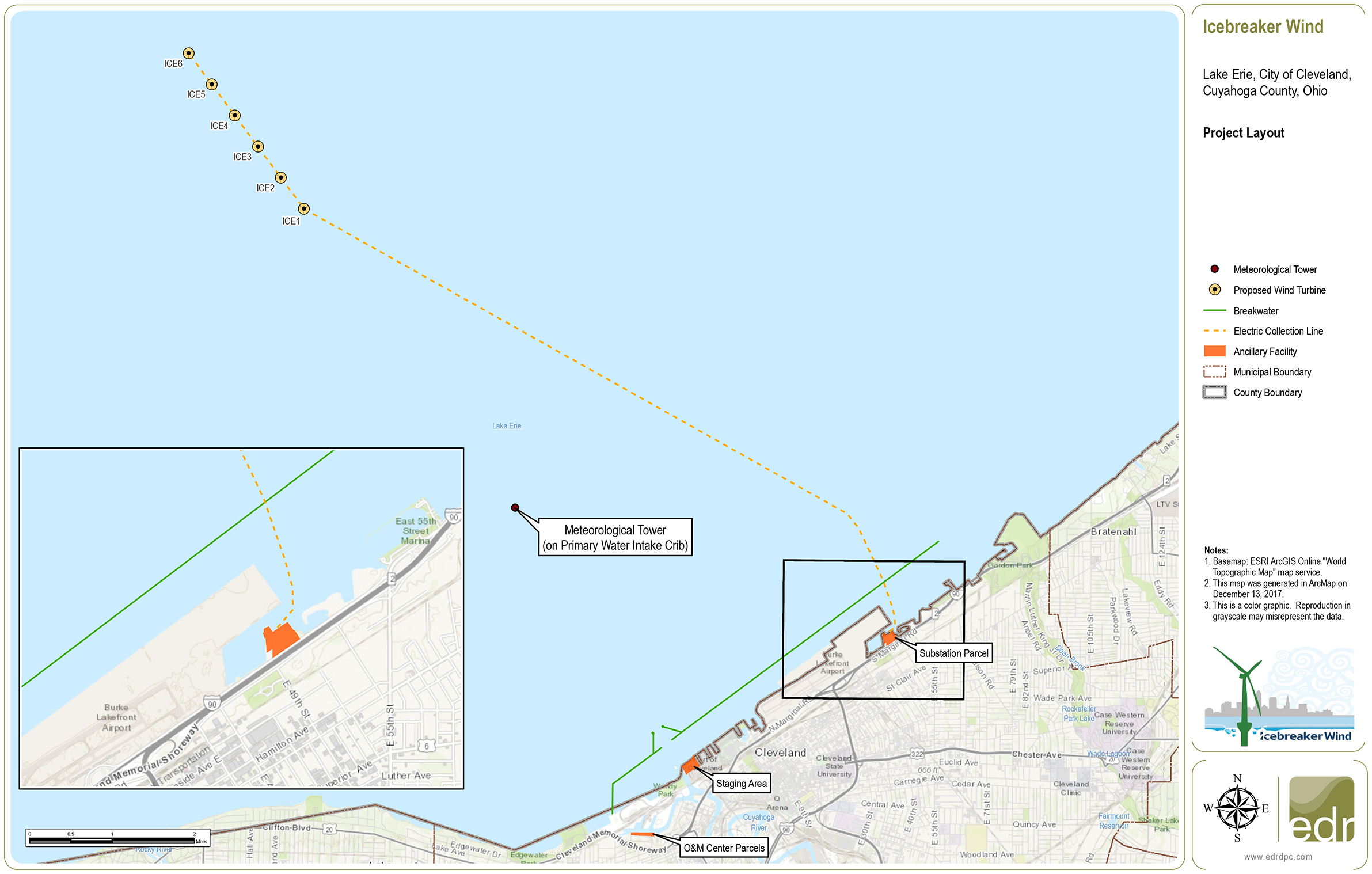Ohio has approved the Icebreaker wind farm in Lake Erie, which will be North America’s first offshore freshwater project, if built. The project, partially funded by a $40 million Department of Energy grant, is contingent on the meeting of 33 conditions before, during, and after construction, including a requirement that the project not be operational during nights for much of the year to protect birds and bats. The condition to stop turbines from operating at night from March 1 until November 1 could kill the project. The Ohio approval certificate is just one among eight major permits from over a dozen state and federal agencies that developers must secure before building the project.
The $126 million, 20.7-megawatt, 6-turbine Icebreaker project is planned for 8 to 10 miles off the Lake Erie shore and will be connected by a 12-mile long underwater cable to a Cleveland Public Power substation. The turbines rise almost 500 feet above the lake and are expected to generate about 75,000 megawatt-hours of energy per year to be sold into the grid operated by PJM Interconnection LLC. If built, the wind farm is expected to be operational in 2022. One of the hurdles that must be overcome is to ensure that the turbines can withstand the force of ice floes during winter.

The project will rely on huge, cone-shaped turbine bases to break the winter ice on Lake Erie as well as special “mono bucket” turbine foundations—mammoth steel suction cups that will be fixed to the floor of the lake—meant to ensure the structures can handle subsurface ice keels. A barge retrofitted with jack-up legs and a large crawler crane will be used to install the turbines.
It is unclear whether the cost of the energy produced by these offshore wind turbines can compete with other technologies due to the massive capital investments that will be required. The builder has agreements to sell about two-thirds of the power to the municipal utility in Cleveland and Cuyahoga County, but still has to obtain other purchase agreements. The expected generation cost for Icebreaker will not be disclosed until all the purchase agreements for the project have been signed.
Because the Icebreaker project is a pilot, representing the first of its kind in North America, it is required to provide a public and transparent data collection and submission process to better inform stakeholders and the public on questions and risks related to the construction and operation of the turbines.
Night Operation
Ohio’s approval requires Lake Erie Energy Development Corporation and its partner, Norway-based Fred Olsen Renewables, to conduct radar studies and provide a bird and bat impact mitigation plan, including a collision monitoring plan. After submitting the monitoring information, the developers could seek nighttime operations between March and November, but until then, the turbines must be “feathered,” or stopped overnight.
Offshore Wind is Expensive
The $126 million cost of the 20.7 megawatt wind farm equals a cost of $6.1 million per megawatt, which is 12 percent more expensive than the average cost of offshore wind ($5.4 million per megawatt) estimated by the Energy Information Administration (EIA). According to EIA, offshore wind is one of the most expensive technologies in the slate of technologies it considers for its Annual Energy Outlook: offshore wind’s capital costs are twice as expensive as the capital costs for onshore wind and over 4 times more expensive in operation and maintenance costs. It is unclear why a technology that is so expensive should be co-funded by $40 million of U.S. taxpayers’ money. Some may remember other expensive outlays of federal funds such as Solyndra that never made it in the private market.
Conclusion
As a demonstration project, the Icebreaker wind farm is receiving funding from the U.S. Department of Energy. It is clearly an expensive project and one that is problematic from the 33 conditions that Ohio has put on its certificate. One of the conditions is that it cannot operate at night for 8 months of the year to protect birds and bats. This condition could be fatal to the project given that the best wind conditions usually occur at night. The project must also get approvals from over a dozen federal and state agencies and additional purchase agreements from major utilities.